The coronavirus pandemic has forced a rapid move into the digital realm upon much of the cultural world, but it’s a shift that Nalini Malani – who has experimented with technology in her work since the 1960s – was more than prepared to embrace.
The artist is usually based in Mumbai, but has been in Amsterdam, in the second home she shares with her Dutch husband, since the start of the coronavirus lockdown. Here, she has set up a studio from which she is coordinating her work around the world, including the display of an installation at the Whitechapel Gallery in London – ensuring that her vision is realised while allowing for sufficient physical distancing when it opens this month.
Malani doesn’t use the term ‘social distancing’, she explains during our video call in July, because it contains echoes of India’s caste system, within which certain social groups are ostracised. Over the course of our conversation, she talks about the impact of the pandemic on her home country – how the rapid implementation of lockdown and the sudden halting of public transportation left migrant workers stranded in cities and forced to walk vast distances to return to their home towns and villages, and of the impossibility of households keeping apart from one another in poorer, more crowded neighbourhoods. ‘The bourgeoisie in India have been protesting as part of the Black Lives Matter movement, but very few people are looking at how marginalised people are treated in their own backyard,’ she says.
Politics forms the framework of her artistic life, perhaps because it has framed her life from the very start. She was born in 1946 in Karachi, a year before the city became part of the new nation of Pakistan. Her family took refuge in Calcutta (now Kolkata) shortly after Partition, before relocating permanently to Bombay (now Mumbai) in 1958. She may have been too young to remember this brutal period of history clearly, but it has fed directly into her work – for example, her first large-scale video installation Remembering Toba Tek Singh (1998–99) is based on Saadat Hasan Manto’s satirical short story about the inhabitant of a lunatic asylum in Lahore who dies on the border between Pakistan and India after refusing to be transferred from one country to the other. ‘Partition created a bloody wound, and we’re still bleeding,’ she says.
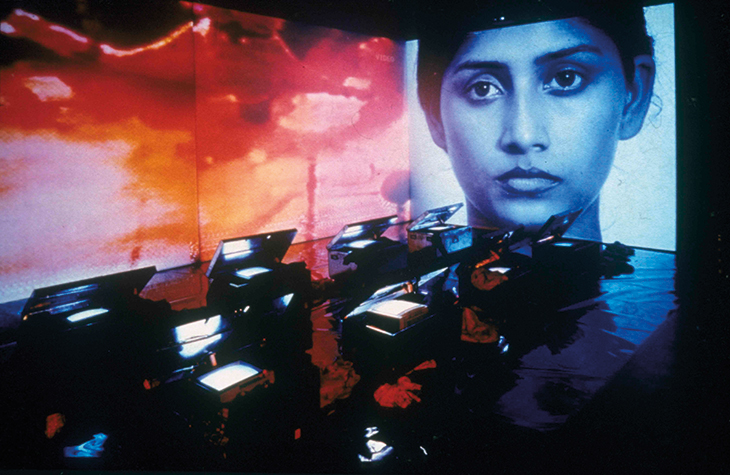
Remembering Toba Tek Singh (1998–99), Nalini Malani. Installation view in Amsterdam, 1998. Queensland Art Gallery, Brisbane. Photo: G.J. van Rooij
Two years ago, she discovered a new outlet – Instagram – and has been posting short animations that she makes on an iPad. ‘I started to make these quick drawings in motion, incorporating a quote about what excited me at the time – whether it was political or personal,’ she says. ‘My daughter, who is an experimental film-maker, suggested I put them on Instagram since they are less than a minute long.’
For the 74-year-old artist, these evocative animations are like sketches – rapidly captured records of her thoughts, memories, ideas and responses to current events, posted with little explanation. In one, uploaded in the first few months of the coronavirus pandemic, a gun labelled ‘the state’ and a begging hand representing ‘the citizen’ flash on the screen, followed by a line from ‘Out of Work’, a poem by Langston Hughes (‘Did you ever try livin’ / On two-bits minus two? […] Why don’t you try it, folks, / And see what it would do to you?’). In another recent video a bent, curled, human figure made of bones smashes its head against the floor until it explodes, with the words ‘I am not a skeleton’ screaming out around it.
Simple but mesmerising, furious and witty, sometimes even hopeful (one quotes Proust: ‘If a little dreaming is dangerous, the cure for it is not to dream less, but to dream more, to dream all the time’), these snippets offer an insight into Malani’s thought process. But her Instagram page is more than just a personal sketchpad. These biting responses to current events are a way of continuing to be critical when many artists in India are afraid to speak up, as the national government undermines the freedom of the press and artistic expression. They continue her efforts since the 1990s to create immersive, multi-layered experiences from a wide range of sources that give viewers a visceral sense of current and historical political injustices.
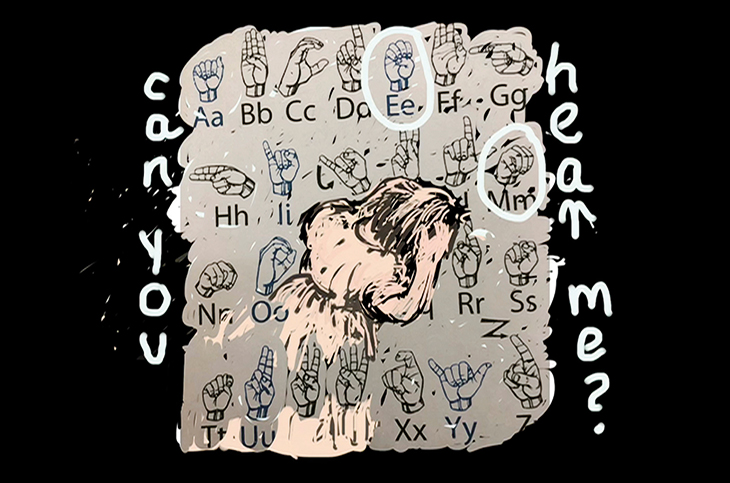
Still from Can You Hear Me? (2018), Nalini Malani. Courtesy Nalini Malani; © Nalini Malani
The installation at the Whitechapel Gallery – titled Can You Hear Me? – draws on these digital sketches. It will comprise 80 moving images projected around the walls, including drawings, notes and fragments of text presented in collage-like fashion, which the artist called an ‘animation chamber’. It’s a version, updated for the space and context, of the exhibition she unveiled at the Goethe Institute in Mumbai in October. Over the past decade or so, her profile has become increasingly international, with solo exhibitions at, to name a few, the ICA Boston (2016), the Centre Pompidou in Paris – making her the first living Indian artist to have a show there – and the Stedelijk Museum, Amsterdam (both 2017), in addition to the major Indian institutions, such as the Kiran Nadar Museum of Art in New Delhi (2015) and the Chhatrapati Shivaji Maharaj Vastu Sangrahalaya in Mumbai (1999).
Malani studied fine art between 1964 and 1969 at the prestigious Sir Jamsetjee Jeejebhoy School of Art, which includes artists M.F. Husain, F.N. Souza and V.S. Gaitonde and architect B.V. Doshi, as well as more recent artists such as Reena Saini Kallat, among its alumni. She began experimenting with new media early on in her career – in 1969, at the Vision Exchange Workshop, an experimental multidisciplinary space in Mumbai, she made a series of colour, stop-motion films called Dream Houses, exploring the ideological possibilities of modernist architecture, inspired by the works of Charles Correa and Buckminster Fuller.
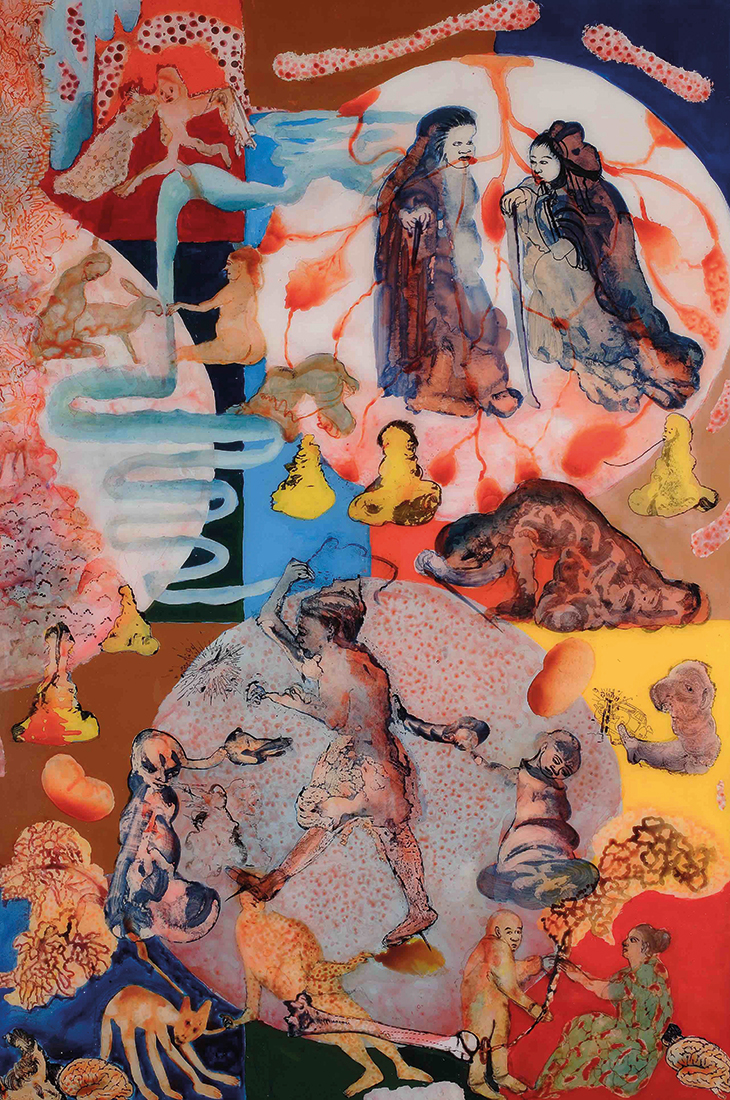
Sita-Medea (2006), Nalini Malani. Photo: Anil Rane; © Nalini Malani
During this time she also became more interested in literature: in the course of creating illustrations to accompany short stories in the Times of India newspaper she noted that the young writers of these nahi kahaniya – ‘new stories’ written in Hindi for the newly independent nation – often drew on Indian epics such as the Mahabharata and Ramayana, recasting the characters in a contemporary context. ‘They were using these stories to reach a wider audience, because everybody in India could identify with those characters,’ she observes. Women from Indian and Greek mythology often appear in Malani’s work, from the Sita-Medea paintings she began making in 2004 to In Search of Vanished Blood (2012), a video work that refers to the mythical seer Cassandra, by way of a novel about her by the East German writer Christa Wolf.
During her studies, Malani had a studio at the Bhulabhai Memorial Institute, a multidisciplinary space in which she encountered and worked closely with actors, musicians, poets and dancers – and saw how theatre connected with the kind of audience that wouldn’t normally enter the city’s elitist galleries spaces. The influence of these encounters with the stage are evident in her work – in ‘erasure performances’ such as City of Desires (1992), a wall drawing that existed for only 15 days in Gallery Chemould in Mumbai, and Memory: Record/Erase (1996), made in just one night as a one-off performance of drawing and erasure – hinting at how memory and identity can be altered and manipulated. Later she started creating the ‘video/shadow plays’ she’s best known for today, such as Remembering Mad Meg (2007), which incorporate video, light projections and rotating cylinders containing reverse paintings – together, these kaleidoscopes of light, colour and shadow create different tones and moods, acting like layers of consciousness both outside and within the brain of the viewer.
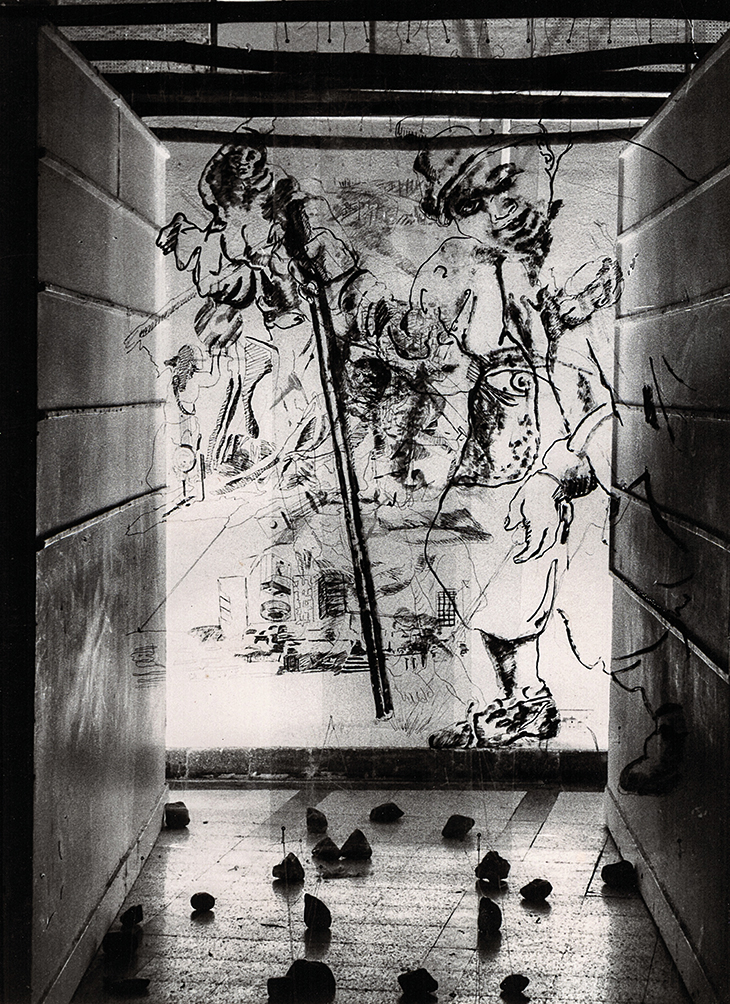
Alleyway Lohar Chawl (1991), Nalini Malani. Installation view at Jehangir Art Gallery, Mumbai, 1991. Photo: Nalini Malani; © the artist
In 1970, Malani received a scholarship to study at the Ecole nationale supérieure des Beaux-arts in Paris. While living in the city, she attended lectures by Noam Chomsky, Claude Lévi-Strauss and Roland Barthes, encountered Simone de Beauvoir and Jean-Paul Sartre in cafes, and met film-makers such as Jean-Luc Godard – soaking up debates about the Black Panther movement, the Vietnam War or the Israeli-Palestinian conflict. Perhaps more significantly she started thinking about India in a new way. ‘I understood my country better from the outside; for example, when a friend gave me a book by socio-anthropologist Louis Dumont about the caste system, it was an eye opener,’ she says. ‘My mother’s family was Sikh and my father’s were theosophists, both religions in which there was no caste, so the idea of caste hadn’t really entered my consciousness until then.’ After that, she returned to India – as she had always planned. ‘My inspiration was Diego Rivera, who returned from France to Mexico to be part of the government-sponsored muralism programme, depicting the people of his country – images that the people could identify with.’
Back in India, she continued to explore techniques such as reverse painting on glass, which she learned from Bhupen Khakhar in 1988. As the method required her to focus first on face, features and expressions, she says, it allowed her to create a strong sense of character in her figurative work. At the same time, she was finding ways to achieve the Rivera effect: she organised an exhibition of female artists that was staged in Delhi in 1985, when such shows were rare in India, and which became a travelling show in a series of public spaces around India later that decade.

Cassandra (2009), Nalini Malani. Kiran Nadar Museum of Art, New Delhi. Photo: Anil Rane; © Nalini Malani
In the 1990s, however, these efforts took on a greater urgency, in line with the political climate in India. The demolition in 1992 of the Babri mosque in Ayodhya by Hindu fundamentalists set off a wave of sectarian violence that resulted in 2,000 deaths. Malani turned again to new media around this tumultuous time. Although the art scene in India was still centred on traditional techniques, Malani’s shift wasn’t primarily about antagonising the establishment, or even about exploring and experimenting with new styles and materials. Rather, she was seeking a popular and accessible medium to communicate with as wide an audience as possible. Video then seemed like the most effective tool to reach out beyond the white cube. ‘Because of the way it’s used in popular cinema, techniques such as collage and montage are understood well in India and are part of the common language,’ she says.
Malani’s recent embrace of Instagram reflects her continuing desire to grasp the potential of popular media and circumvent the gatekeepers of the art world. Meanwhile, the themes she grappled with early in her career remain as relevant as ever. This August, 28 years after the demolition of the Babri Masjid, India’s prime minister Narendra Modi laid the foundation stone for a Hindu temple on the site of the mosque. Malani has frequently examined the ideology of ‘Hindutva’ over the course of her career in works such as Unity in Diversity (2003), which explores the fracturing of India’s claims to embody cultural plurality and secularism. This video installation depicts women wearing traditional outfits from various parts of the country and playing instruments together in harmony, interspersed with violent images relating to the anti-Muslim pogrom in Gujarat that Modi as chief minister did nothing to stop and even facilitated in 2002.
While the Indian context is central to her work, Malani’s explorations are nonetheless universal and timeless – themes such as jingoistic nationalism, violence against women, and the oppression of marginalised people know no borders. Nor does she think an artist should be constrained by artificial boundaries. In her Whitechapel work, one of the main themes explored is ‘malevolent or toxic masculinity’ (a term she prefers to ‘patriarchy’, which she argues carries suggestions of being paternal, caring and concerned) and its dominance around the world. She mentions rapes and murders in India, but has also been reading The Five (2019), a book by Hallie Rubenhold about the women killed by Jack the Ripper, whose crimes took place in Whitechapel near the gallery, considering how the categorisation of women as either pure or tainted continues almost everywhere today.
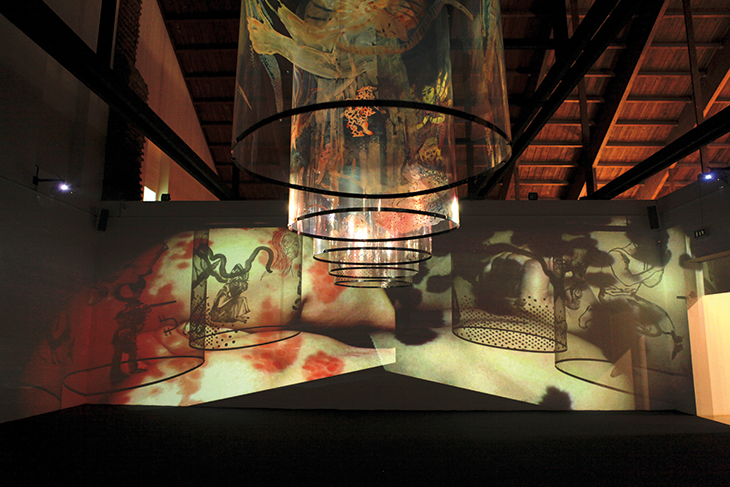
In Search of Vanished Blood (2012), Nalini Malani. Installation view at the Castello di Rivoli in 2018. Burger Collection, Hong Kong. Photo: Ranabir Das; © Nalini Malani
She is also interested in the broader societal impact of traditionally masculine values – their effect on marginalised and dispossessed people in general and on the planet’s ecosystem. Malani emphasises that she isn’t using ‘feminine’ and ‘masculine’ to refer to men and women necessarily. Rather, it’s a shorthand for the complementary tendencies that she believes exist within us all. In mythology, she points out, female characters are often associated with the earth and the gagging of the feminine voice that exists inside all of us, she argues, has contributed to environmental degradation. ‘If there is a future it has to be female,’ she says. Masculinity is also the central theme of ‘You Don’t Hear Me’, an exhibition currently at the Fundació Joan Miró (until 29 November) – she was the winner of the 2019 Joan Miró Prize.
As she embarks on a two-year fellowship with the National Gallery in London and the Holburne Museum in Bath, Malani is excited by the prospect of spending time with paintings by artists ranging from Piero della Francesca to William Hogarth as she researches and produces a new body of work to exhibit. While the medium of video certainly lends itself to cutting, pasting and mixing together ideas from many sources, Malani points out that this is how art has always been created – it’s just that Western artists such as Picasso have long been given more leeway to co-opt and plunder ideas from other cultures than artists from places that were colonised, and who are considered derivative if they do the same. It’s a well of inspiration, she argues, on which we all have a right to draw. ‘The compendium of all cultures is a lexicon for all artists.’

Nalini Malani, photographed at home in Amsterdam in August 2020. Photo: Johan Pijnappel
‘Can You Hear Me?’ is at the Whitechapel Gallery, London, from 23 September–May 2021.
From the September 2020 issue of Apollo. Preview and subscribe here.
Unlimited access from just $16 every 3 months
Subscribe to get unlimited and exclusive access to the top art stories, interviews and exhibition reviews.


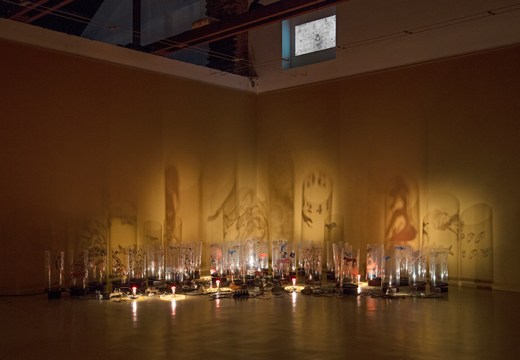
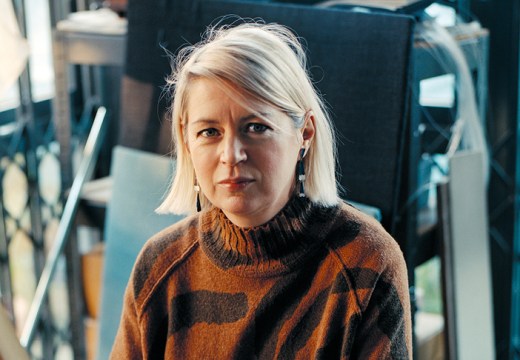
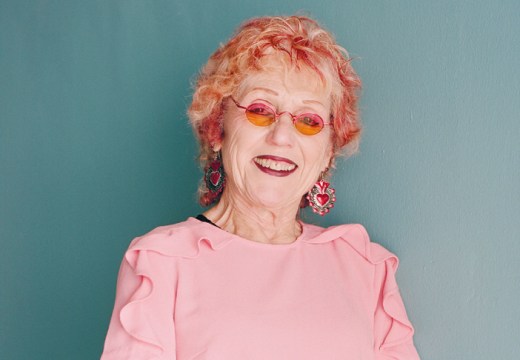









![Masterpiece [Re]discovery 2022. Photo: Ben Fisher Photography, courtesy of Masterpiece London](http://www.apollo-magazine.com/wp-content/uploads/2022/07/MPL2022_4263.jpg)
Has the Fitzwilliam lost the hang of things?